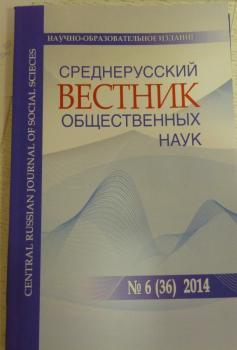The presented research was conducted to determine the main problem fields of modern empirical perception of Europe as well as to describe the used methodology and the achieved results in these studies. In the course of work the authors of the study analyzed modern publishing of foreign authors in scientific journals devoted to the study of various aspects of the perception of Europe image in the eyes of the multicast target audience. As a result, the authors were able to identify a number of areas in modern foreign studies that reflect the desired problem fields. These included: the study of various aspects of the content of the image of Europe, including the geographic parameters of its image; European research in perception of dichotomy WE-THEY; analysis of the external image of Europe; study of the image of Europe as a part of identity; the study of their own and the other for the European elite. As the subjects in the studies different groups of respondents are mentioned: youth and students, the population of the European countries in general, the political and economic elite. Considerable attention is paid to the European perception of non-Europeans. The urgency of the problems investigated in the foreign papers in the field of perception of the image of Europe, does not lose its relevance in contemporary international relations. Methodical and informative potential of European research will be useful for the study of the perception of Europe and own country by Russians.
perception of Europe, European identity, national and state identity, European brand, the European Union
1. Chaban N., Elgstrom O., Kelly S., Yi L. Images of the EU beyond its Borders: Issue-Specific and Regional Perceptions of European Union Power and Leadership. Journal of Common Market Studies 2013. Vol. 51, No. 3, pp. 433-451.
2. Dias. V.A. The EU and Russia: Competing Discourses, Practices and Interests in the Shared Neighborhood// Perspectives on European Politics and Society, 2013. Vol. 14, No. 2, rr.256-271.
3. Elgstrom O. Outsiders’ Perceptions of The European Union In International Trade Negotiations. Journal of Common Market Studies, 2007 Vol. 45, No. 4, pp. 949-967.
4. Kask K., Hannust T. Does a Dozen Years Change a Thing? Estonian Children’s Drawings of Europe in 2000 and 2012. Trames, 2013.Vol. 17, No. 3, pp. 301-312.
5. Lucarelli S. Seen From the Outside: The State of The Art on The External Image of the EU. Journal of European Integration, 2013. Vol. 35, No. 6, pp. 1-16.
6. Mason R. School Children’s Visualizations of Europe. European Educational Research Journal, 2012. Vol. 11, No. 1, pp. 145-165.
7. Matonyte I., Morkevicius V. Threat Perception and European Identity Building: The Case of Elites in Belgium, Germany, Lithuania and Poland. Europe - Asia studies, 2009. Vol. 61, №6, pp. 967-985.
8. Memoli V., Pellegata A. Corruption and EU Institutions: The Italians’ Opinion. Perspectives on European Politics and Society, 2014. Vol. 15, No. 2, pp. 165-182.
9. Portela C. The Perception of The European Union in The Southeast Asia. Asia Europe Journal, 2010. Vol. 8, No. 2, pp. 149-160.
10. Sarno F. Italian mafias in Europe: between perception and reality. A comparison of press articles in Spain, Germany and the Netherlands. Trends in Organized Crime, 2014. Vol. 17, Issue 4, pp. 313-341.
11. The Europe Brand: perception in France, Germany, Italy and the -URL: http://www.nomen.fr/wp-content/uploads/europe-brand-perceptions-in-ue.pdf (data obrashcheniya: 08.09.2016).
12. Torney D. External Perceptions an EU Foreign Policy Effectiveness: The Case of Climate Change. Journal of Common Market Studies, 2014. Vol. 52, No. 6, pp. 1358-1373.





